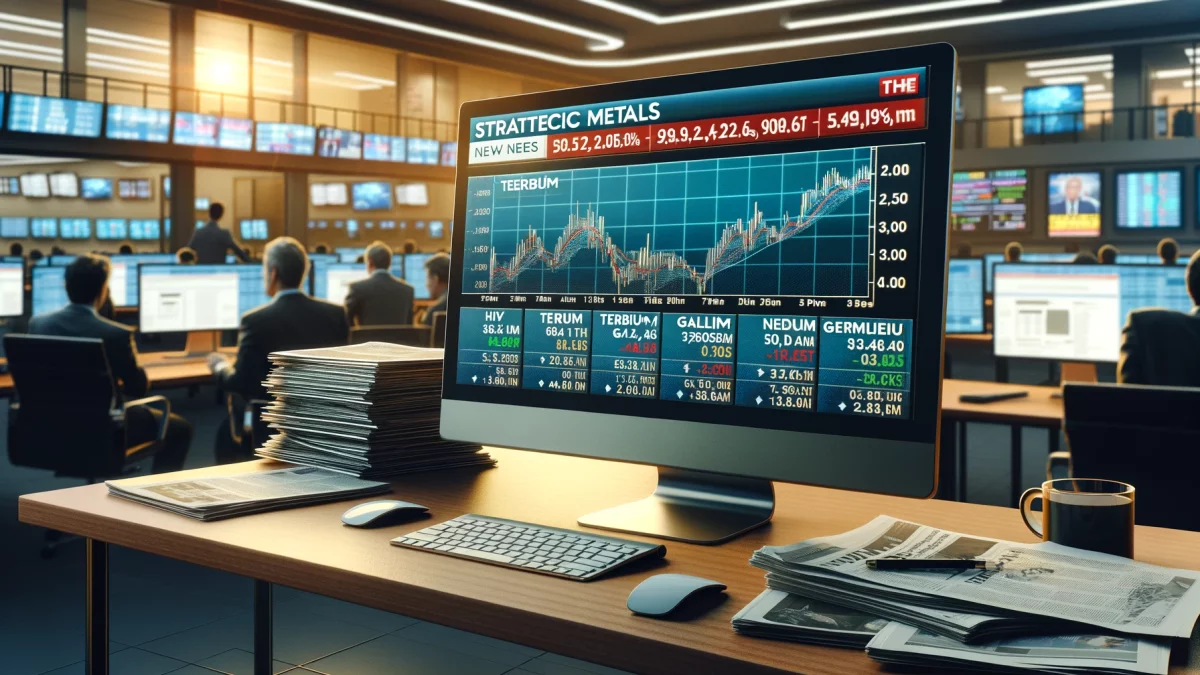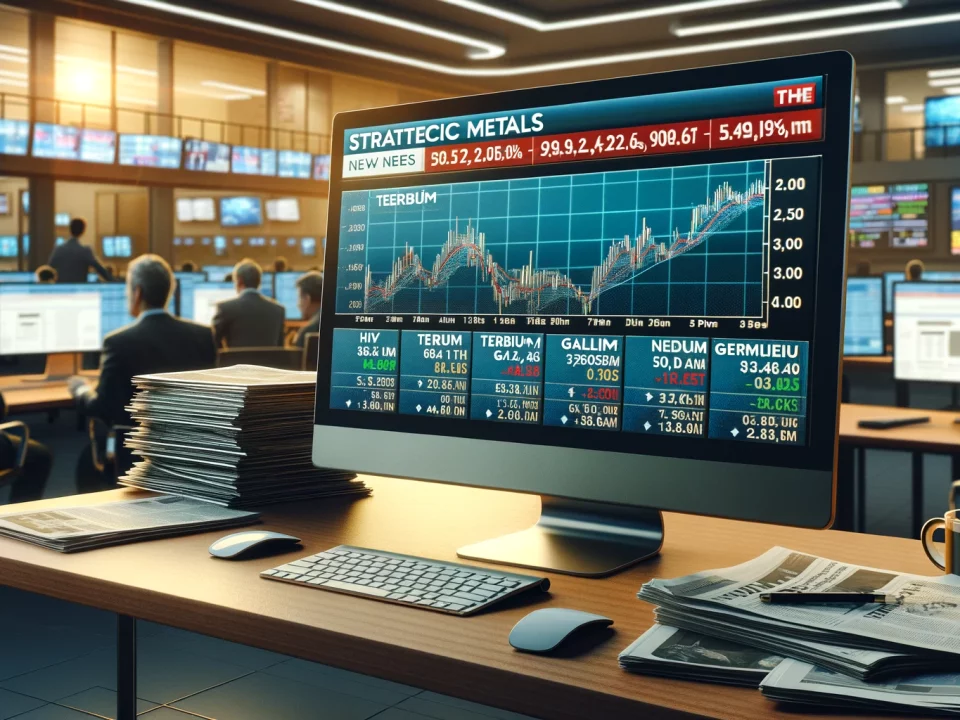
Weekly News Review August 11 – August 17 2025
August 17, 2025
Weekly News Review August 25 – August 31 2025
August 31, 2025The Chinese customs authorities published detailed July export data this week, showing signs of easing in critical mineral shipments. However, while volumes increased, the number of recipients of gallium, terbium, and the like continues to dwindle.
This and more from the newsroom in our weekly news review.
CHINA: GALLIUM, GERMANIUM EXPORTS INCREASE IN JULY; HOWEVER, DESTINATIONS NARROW –
Germanium continues to trail gallium and remains at historic low levels.
China significantly increased gallium exports in July, according to the latest customs data. A total of 9,007 kilograms of the critical metal left the country last month, more than double the June level of 4,260 kilograms. The shipments went exclusively to Germany, which received 5,000 kilograms, and Japan, with 4,007 kilograms, leaving other countries excluded. By comparison, in July of last year, China exported at a similar level, highlighting a recovery in volume but not in trading partners.
Germanium shipments also showed signs of recovery, though still far below historic levels. Exports totaled 763 kilograms in July, up from just 96 kilograms in June. Here, the number of recipients also dwindled to just a few: Germany received 392 kilograms, Japan 352 kilograms, and Russia 19 kilograms. In July 2024, exports stood at twice the amount.
Both gallium and germanium are essential to high-tech industries, particularly in semiconductors, fiber optics, and advanced optics, such as infrared systems. China is the world’s leading producer of both metals, and exports have been subject to a licensing regime since mid-2023. Official processing times are 45 working days, though companies report longer delays and ongoing uncertainty. A ban on shipments of both metals and other critical minerals to the United States, in place since December 2024, continues to reshape supply chains.
CHINA: EXPORTS OF DYSPROSIUM AND TERBIUM SHOW INCREASE –
China is resuming exports of dysprosium and terbium. However, the number of destinations is dwindling. According to new data from Chinese customs authorities, the country shipped 1,400 kilograms of dysprosium and 7,000 kilograms of terbium in July. All dysprosium exports went to South Korea, while terbium was split almost equally between South Korea and Japan. In comparison, in the same period last year, China exported terbium to a total of nine countries.
In June, exports were minimal, with only 1 kilogram of dysprosium and 1,200 kilograms of terbium leaving China. This is due to the export licensing system that has been in place since April for both metals. Despite the recent recovery, current levels remain well below those of the previous year. The trend mirrors that seen with other technology metals such as gallium and germanium. Since summer 2023, export restrictions on these metals have caused shipments to initially grind to a halt, with a slow recovery afterward—but volumes remain very low. The number of trade partners has also decreased.
Dysprosium and terbium are key raw materials for a wide range of high-tech applications, from semiconductor manufacturing to the chemical industry. Their most important use, however, is in neodymium-iron-boron (NdFeB) magnets.
CHINA BOOSTS RARE EARTH MAGNET EXPORTS: TOP DESTINATION IS GERMANY –
According to data from Chinese customs authorities, exports of permanent rare-earth magnets rose sharply in July. Compared with June, shipments of these components, used, among other applications, in wind turbines and electric motors, increased by 75 percent. Germany was the largest destination, receiving 1,116 tons, nearly one-fifth of the total export volume.
The United States ranked second, followed by South Korea, Vietnam, and India. The Indian automotive industry had recently complained about supply difficulties, as export restrictions on certain rare earths had significantly reduced material availability in the market.
The data does not specify the exact type of rare-earth magnets exported, nor whether high-performance magnets containing restricted elements such as dysprosium, terbium, or samarium are included. Regardless of their specific composition, all rare-earth magnets are recorded under a single customs code in China.
EUROPE: FIGHTING THE PLASTIC TIDE WITH RARE EARTHS –
Researchers have developed a type of plastic that could be recycled indefinitely without any loss of quality.
Plastic pollution is among the world’s most pressing environmental challenges. According to the United Nations, 400 million tons of new plastic waste are generated every year. A recent attempt to reach a global agreement to curb plastic production and pollution has failed, and it remains unclear whether negotiations will resume.
In the meantime, research efforts in many countries are focusing on developing eco-friendlier materials and more effective recycling methods. Raw materials often play a decisive role in such innovations, just as rare earth elements and LEDs containing metals like gallium and indium have now enabled a potential breakthrough.
At Eindhoven University of Technology in the Netherlands, a team led by Assistant Professor Fabian Eisenreich may have found a way to recycle plastics repeatedly without any loss in quality. Conventional recycling methods usually involve melting and reshaping plastics, which gradually degrade their properties. Eisenreich’s team takes a different approach: designing plastics so that they can later be broken down into their original chemical building blocks. These base molecules can then be reassembled into new plastics with identical quality.
Cerium and LED Light Trigger the Key Chemical Reaction:
Both the production and recycling of the material rely on a photocatalyst made from the rare-earth metal cerium, a substance that initiates chemical reactions under LED light. Eisenreich and doctoral researcher Ahsen Sare Yalin report that they are the first to successfully demonstrate such a closed recycling loop in the lab. Their publication in the Rising Stars edition of the journal Advanced Materials underlines the scientific importance of their work.
Tests show that the new material remains stable at temperatures above 300°C. However, it is still brittle and tends to adhere to other substances such as glass or polycarbonate. For now, the researchers see potential mainly in niche applications, such as recyclable adhesives. Their next step is to refine the designer material so it can be applied across a broader range of uses.
UNITED STATES EXPANDS STRATEGIC METALS STRATEGY WITH NEW STOCKPILE:
The most extensive ammunition base in the world could host strategic reserves of critical raw materials.
The United States is accelerating its critical minerals strategy, launching a new Nevada-based reserve and rebuilding cobalt stockpiles as part of a broader effort to secure supply chains and strengthen national security.
Two private companies, M2i Global and Volato Group, backed by the Department of Defense and the Department of Energy, plan to set up the Strategic Mineral Reserve (SMR) at the Hawthorne Army Depot in Nevada, the world’s largest ammunition depot. According to the companies, the SMR will store gallium, graphite, copper, and other critical materials. Unlike traditional stockpiles, it will also invest in refining capacity and strategic planning.
Pentagon Rebuilds Cobalt Reserves:
Simultaneously, the Defense Logistics Agency (DLA) has announced it will issue its first cobalt tender in decades, seeking 7,500 tons over five years in contracts worth up to $500 million. Potential suppliers include Canadian miner Vale, Japan’s Sumitomo Metal Mining, and Glencore, according to Bloomberg Law. The purchases could represent one-sixth of the global non-Chinese alloy-grade cobalt supply, a significant intervention in the market.
Congress Passes Sweeping Minerals Law:
The One Big Beautiful Bill Act backs these moves, passed in July (we reported). The law directs $2 billion to expand the National Defense Stockpile and $500 million to the Pentagon’s loan program, while phasing out tax credits for new mineral projects between 2031 and 2034. Combined with President Trump’s March 2025 order to fast-track mine and processing permits, the legislation underscores a strategic shift away from tax-driven incentives toward direct federal procurement and stockpiling.
UNITED STATES: FRESH FUNDING FOR CRITICAL RAW MATERIALS –
The government may redirect money from the CHIPS and Science Act.
The CHIPS and Science Act, signed into law in 2022 by then-President Joe Biden, was initially designed to boost the U.S. semiconductor industry. The package allocated $280 billion for research, development, and manufacturing support.
Now, according to insiders cited by Reuters, part of those funds could be redirected to support projects in critical minerals. At least $2 billion may be made available, benefiting not only mining companies but also refiners and recycling firms. No official confirmation has been issued so far.
The report follows recent announcements from the U.S. Department of Energy, which pledged nearly $1 billion for critical raw materials projects. At the same time, the Pentagon has taken a more direct role, becoming a shareholder in MP Materials, the country’s leading rare earths producer.
Alongside an offtake agreement, the Defense Department has guaranteed minimum prices for the company’s neodymium-praseodymium (NdPr) output. In addition, the U.S. is ramping up raw material stockpile plans.
Such state-backed price guarantees and long-term supply contracts are seen as key incentives for rebuilding critical mineral supply chains in Western countries.
CHINA FURTHER STRENGTHENS CONTROL OF ITS DOMESTIC RARE EARTH SECTOR –
A new set of rules replaces the 2012 version, giving the central government more information and control over the industry.
The Chinese government has introduced a new set of regulations to strengthen oversight of its rare earth industry, a strategic sector for global technology and defense supply chains. The “Interim Measures for the Regulation and Management of Rare Earth Mining and Rare Earth Smelting and Separation” establishes a comprehensive framework that goes beyond the country’s existing quota system. Initially proposed in February, most of the draft measures have now been formally adopted.
It replaces an existing framework, in place since 2012, which focused mainly on mining and smelting operations. The new rules expand oversight to the entire rare earth production process, as well as imported material. They introduce “total control indicators”, setting annual production limits for approved enterprises based on national economic goals, resource reserves, environmental protection, and market demand.
Enterprises are now required to report monthly operational data before the tenth of each month, whereas previously only overall production volumes were reported. Violations may result in administrative penalties or reductions in future production quotas, as was stipulated in past rules.
Notably, the final rules omit any mention of export licenses, a departure from the initial proposal.
The Measures also explicitly state that only officially approved enterprises are permitted to engage in rare earth mining, smelting, and separation, reinforcing state control over this strategically important sector.
Unlike the previous framework, which primarily relied on local authorities for enforcement, the new rules place greater emphasis on central government oversight, ensuring more uniform implementation and tighter regulatory control across the country.
TUNGSTEN SUPPLY CRUNCH: CHINA’S EXPORT CUTS RATTLE GLOBAL MARKETS –
Chinese exports have been declining since 2021, causing prices to skyrocket.
Tungsten is a strategic metal prized for its exceptional hardness, high density, and the highest melting point of any element at 3,422 °C. These unique properties make it indispensable across a wide range of industrial and defense applications.
Despite its critical importance, Western countries remain heavily dependent on imports. The United States, for example, has not had domestic tungsten production since its last mine closed in 2015. Today, China dominates the global market, accounting for more than 80% of the total mine production.
In February, Beijing expanded its export control list to include multiple tungsten compounds, making overseas shipments subject to licensing. The Chinese government classifies tungsten as a “dual-use” material, reflecting its role in both civilian and military sectors.
While many associate tungsten with cutting and drilling bits or lighting filaments, its strategic value also lies in the defense sector: its hardness makes it essential for armored vehicles and tanks, while its high melting point is critical for rocket and aircraft components.
Notably, tungsten is indispensable in the production of both advanced armor and armor-piercing ammunition.
Figure of the Week: – 83% – of significant raw material development and processing projects face cost overruns exceeding 40% and delays of 20–30%.






